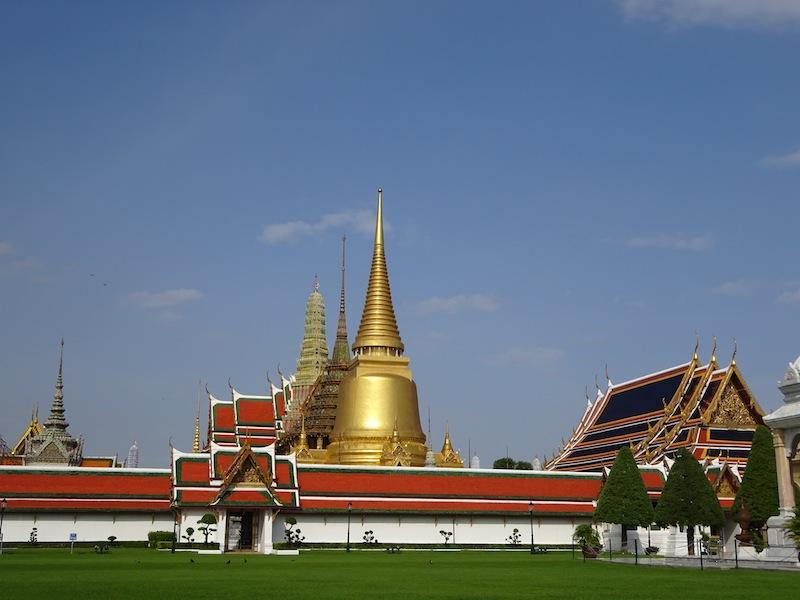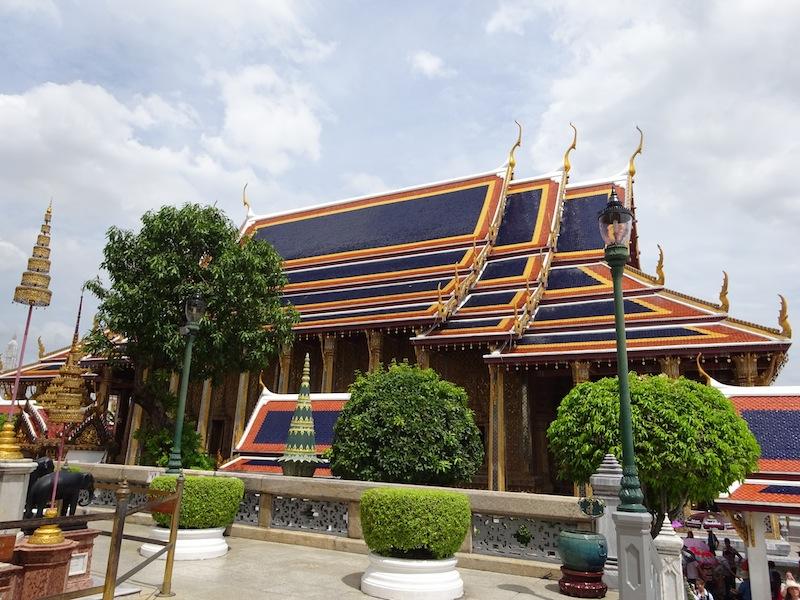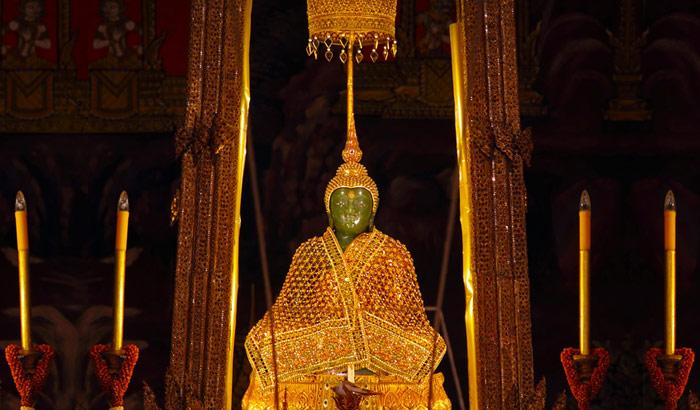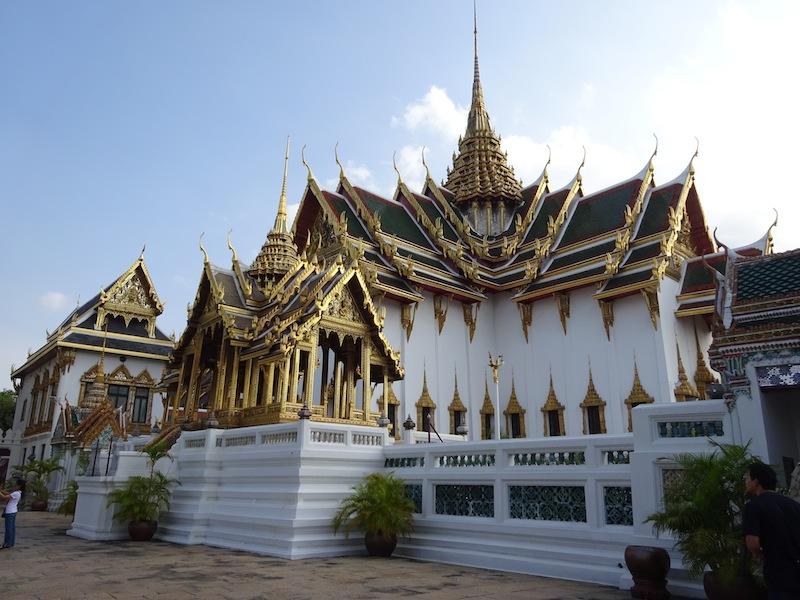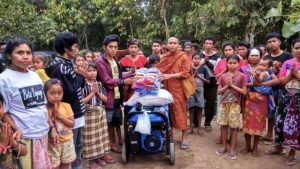First-time travelers to Bangkok like myself surely won’t miss the opportunity to visit treasures like Wat Pho (The Temple of the Reclining Buddha), Wat Arun (The Temple of Dawn), Wat Saket (The Temple of the Golden Mount), and Wat Phra Kaew (The Temple of the Emerald Buddha). After visiting Wat Pho, my two brother monks Venerable Sanghapriya and Venerable Tilokananda and I made our way to the Temple of the Emerald Buddha, which is located inside the grounds of the Grand Palace, a short distance on foot from Wat Pho. Although I was somewhat aware of the importance of the Grand Palace, I had not expected its architecture to be quite so beautiful.
By the time we entered the palace grounds, it was already late afternoon. I was attracted by several remarkable-looking buildings within the complex, but as there was very little time before the Temple of the Emerald Buddha closed, we hurried to visit it and pay homage to the Buddha. We were fortunate to be able to get in just before the doors were locked, and as the security guard regretfully told us we would not have much time, we immediately prostrated before the Buddha. When we left, I remarked to my brother monks that the Emerald Buddha had seemed to me quite marvelous, and that I had found the statue’s gaze mesmerizing. But there are a number of strict rules for visitors to follow while inside the hall, including no taking of photographs or videos. However, many tourists were keen to take a photo of the Buddha in secret, and when one tried to do so, two guards immediately approached and told him to delete it before they were obliged to take official action.
The Grand Palace consists of a number of buildings in different architectural styles. Within the temple grounds there are also a great many stunning works of artistic value, including whimsical mythical creatures like monkey-demons, and fierce-looking giants and Cambodian-style bronze lions guarding the gates. And on the inner walls of the compound is the longest mural in the world—6,600 feet—depicting scenes from the famous Hindu epic Ramayana. But it was now sundown, and security guards were closing all the gates. As we were leaving, I remarked on how well maintained the place was, and how much tourists must enjoy it—I had in fact been surprised to see such a large number of visitors. As we had had so little time I planned to come back, and was fortunately able to do so the next day with my Thai friend, Phadungpon Rungmee, and brother monk Venerable Nipulananda.
The following day I was better prepared, having read up on the history of both the palace and the Emerald Buddha. The complex of buildings constituting the Grand Palace (Th. Phra Borom Maha Ratcha Wang) covers 2,351,000 square feet, and became the official residence of the king in 1782. After the fall of the Ayutthaya kingdom in 1767, the new monarch, Taksin (r. 1767–82), moved the capital from Ayutthaya to Thonburi on the west side of the Chao Phraya River. Upon ascending the throne, Rama I (r. 1782–1809) of the new Chakri dynasty moved the capital and center of administration to the other side of the river from Thonburi. In addition to erecting public monuments such as fortifications and monasteries, he also built the Grand Palace, which served as the home of the monarch, the administrative seat of government, and the royal court until 1925. Bhumibol Adulyadei (Rama IX), the present king, now uses Chitralada Palace as his official Bangkok residence instead, although the Grand Palace is still used for official events.
Made of green jasper, the Emerald Buddha is 30 inches tall and depicted in meditation posture. According to legend, the statue was made in India in 43 BCE by one of the 18 arhats, Nagasena, and taken to Ceylon 300 years later to save the country from civil war. In 457 CE the statue is said to have been sent to Burma by ship to help promote Buddhism. Shipwrecked off the coast of Cambodia, however, it stayed in that country until being taken to Ayutthaya in 1432, when the Siamese captured Angkor Wat.
My friend Rungmee is very familiar with the Grand Palace, and explained Thailand’s art, culture, and archeology as he showed us the important places in the compound. This time I was able to get a closer look at the Ramayana painting on the walls. Reflecting Southeast Asia’s early Hindu influence, the Ramayana was rewritten as a Thai national epic called Ramakian in the reign of Rama I, the stories from which served as the inspiration for the paintings on the palace walls. There are 178 scenes altogether, depicting values such as honesty, faith, and devotion. The interior walls of the Temple of the Emerald Buddha are also decorated with murals, here depicting the life of the Buddha, the stages to Enlightenment, and images from the Buddhist cycle of existence. Even though the place was so crowded, I felt both calm and inspired by the Emerald Buddha, enabling me to reflect on the Buddha’s teaching in India 2,500 years ago.
There are many other monuments in the palace grounds, but the most interesting are three pagodas. One is a Sri Lankan-style stupa called Phra Si Ratana Chedi, which was built in the 19th century and contains some of the Buddha’s relics. The second pagoda is called Phra Mondop. Built in the Thai style, it is famous for its well-crafted, Ayutthaya-style mother-of-pearl doors, and is protected by human- and dragon-headed snakes (nagas) and statues of the Universal Ruler (P. cakkavatti;Th. cakkraphat). This pagoda houses a library containing a copy of the Tipitaka, the sacred Buddhist texts. To the north of the library is a model of Angkor Wat, the most sacred place in Cambodia. The third pagoda is the Royal Pantheon, and was built in the Khmer style during the 19th century.
The museum at the Grand Palace is also one of the main attractions, with displays of Buddha statues, precious objects, and numerous architectural elements that were removed during various renovations of the Grand Palace and the Emerald Buddha temple. Scattered around the palace grounds as well are a great many statues of elephants, the symbol of independence and power, on which the Thai kings used to promenade to symbolize that they were going into battle.
As I left the Grand Palace with my friends to go to Wat Arun, the Temple of Dawn, I remarked to my Thai friend that the temple had been one of my favorite sites in Bangkok. “The Emerald Buddha is venerated with such devotion that it leaves people with a feeling of peace,” I enthused.This article was inspired by a trip the author made to Thailand this summer. See his previous article, “Inspiration at Wat Pho Temple, Bangkok.”



